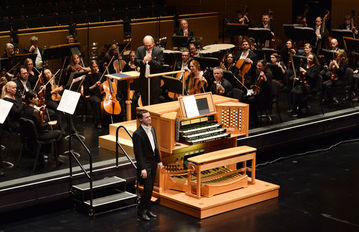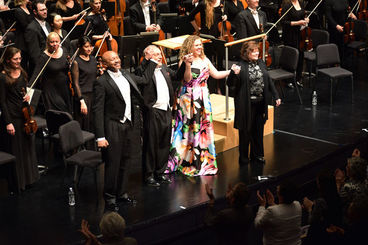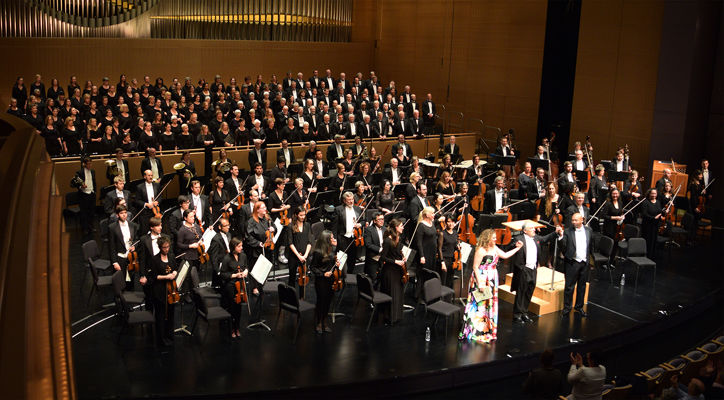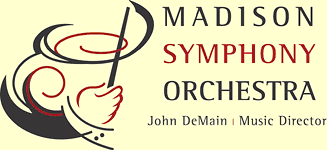Madison symphony orchestra & chorus
MSO was joined by the Madison Symphony Chorus under the direction of Beverly Taylor. The integration of voices and instruments was without peer.
by Michael Muckian
 Organist Nathan Laube
Organist Nathan Laube The Madison Symphony Orchestra learned long ago to cap its annual concert series with a major choral work, one that brings a lot of musicians and voices together on stage for a rousing seasonal finale. This year’s choice was Johannes Brahms’ A German Requiem, Op. 45 that struck one of the highest notes of what had been a stellar year for the orchestra at Overture Hall this past weekend.
Given both the ensemble and the composition, that musical victory came as no surprise. What did catch the audience off guard, however, was the evening opener, the simply titled Concert Piece for Organ and Orchestra, Op. 181, by little known composer Charles Villiers Stanford.
None of us were prepared to like an organ work quite that much. Neither did we know beforehand that this would be the American premiere of a composition written in 1921, but never performed publically until 1990.
Irish composer Stanford was well known in his day as a music teacher, composer and champion of something called the Second English Musical Renaissance, a late 19th Century effort by British composers to strike their own path in a concert scene dominated by their German Romantic counterparts. Stanford, who taught at Cambridge and the Royal College of Music, could count among his students luminaries such as Gustav Holst and Ralph Vaughan Williams who helped further the cause.
None of us were prepared to like an organ work quite that much. Neither did we know beforehand that this would be the American premiere of a composition written in 1921, but never performed publically until 1990.
Irish composer Stanford was well known in his day as a music teacher, composer and champion of something called the Second English Musical Renaissance, a late 19th Century effort by British composers to strike their own path in a concert scene dominated by their German Romantic counterparts. Stanford, who taught at Cambridge and the Royal College of Music, could count among his students luminaries such as Gustav Holst and Ralph Vaughan Williams who helped further the cause.
 DeMain, Jones, Guthrie, & Taylor
DeMain, Jones, Guthrie, & Taylor The concert work in question, performed on the Overture Hall organ by guest artist Nathan Laube, calls for the orchestra’s string, brass and percussion sections. The MSO musicians interacted seamlessly with the organ, performing boldly and moving from tragic mood to lyrical hymn, ending with a blazing coda that won a warm audience response.
MSO Maestro John DeMain had previously prepped the audience that Laube, a concert artist who also teaches at the Eastman School of Music, had a fairly provocative encore ready if we so desired.
The audience took the bait, but it didn’t take much coaxing to get Laube back on stage to perform the Allegro movement from Symphony No. 6, Op. 42 by Charles-Marie Widor, a thunderous organ solo that was even better appreciated by the audience than the Stanford work, and brought most of them to their feet.
And that was just for openers. The mammoth Brahms work, all 68-minutes of it, anchored the evening’s second half.
The German Requiem, completed in 1869, is one of few such pieces not written in the Latin of the Catholic Church. Brahms plucked his sacred text from Martin Luther’s Lutheran Bible, thinking it only fair then to cast the choral parts in his native German. English translations were available in the evening’s program as well as through supertitles above the stage.
MSO Maestro John DeMain had previously prepped the audience that Laube, a concert artist who also teaches at the Eastman School of Music, had a fairly provocative encore ready if we so desired.
The audience took the bait, but it didn’t take much coaxing to get Laube back on stage to perform the Allegro movement from Symphony No. 6, Op. 42 by Charles-Marie Widor, a thunderous organ solo that was even better appreciated by the audience than the Stanford work, and brought most of them to their feet.
And that was just for openers. The mammoth Brahms work, all 68-minutes of it, anchored the evening’s second half.
The German Requiem, completed in 1869, is one of few such pieces not written in the Latin of the Catholic Church. Brahms plucked his sacred text from Martin Luther’s Lutheran Bible, thinking it only fair then to cast the choral parts in his native German. English translations were available in the evening’s program as well as through supertitles above the stage.
The seven-movement work liberally taps into various books from the Old and New Testaments, the Apocrypha and a few other sources. Like all requiems, the Brahms work is still a mass for the dead, and one that celebrates the glory of the afterlife. It’s thought that the death of Brahms’ mother and his mentor Robert Schumann helped prompt its composition.
MSO was joined by the Madison Symphony Chorus under the direction of Beverly Taylor. The integration of voices and instruments was, as usual, without peer. Guest artists soprano Devon Guthrie and bass-baritone Timothy Jones joined the local performers on stage, each turning in fine, albeit short performances as called for by the score.
The requiem’s huge musical arc was carried through Brahm’s lengthy composition with considerable aplomb by all the musicians and vocalists, who were well-equipped to take on the composition’s challenges. The audience, which may have numbered just a little more than half the house, rewarded the effort with its usual standing ovation. Unlike some cases, this one was well deserved for a performance sublime in both its details and execution.
MSO was joined by the Madison Symphony Chorus under the direction of Beverly Taylor. The integration of voices and instruments was, as usual, without peer. Guest artists soprano Devon Guthrie and bass-baritone Timothy Jones joined the local performers on stage, each turning in fine, albeit short performances as called for by the score.
The requiem’s huge musical arc was carried through Brahm’s lengthy composition with considerable aplomb by all the musicians and vocalists, who were well-equipped to take on the composition’s challenges. The audience, which may have numbered just a little more than half the house, rewarded the effort with its usual standing ovation. Unlike some cases, this one was well deserved for a performance sublime in both its details and execution.




